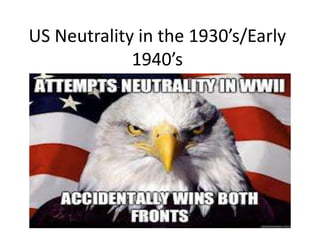
Us neutrality in the 1930’s
- 1. US Neutrality in the 1930’s/Early 1940’s
- 2. Neutrality in General • The Neutrality Acts were passed by the US in the 1930s in response to the issues in Europe and Asia that eventually led to World War II • They were caused by the desire to be isolationist in the US following WWI • Passed to ensure that the US would not become involved in world conflicts(war) • US had very strong history of isolationism
- 6. Neutrality Act of 1935 • Signed on August 31, 1935 • It was designed to last six months • Banned US trade of arms and war materials with any country at war • It also declared that US citizens traveling on warring ships traveled at their own risk
- 7. Neutrality Act of 1936 • Signed in February 1936 • Renewed the provisions of the 1935 act for another 14 months • It also forbade all loans or credits to belligerents • The act did not cover "civil wars," such as the Spanish Civil War • The act also did not cover materials such as trucks and oil
- 8. Neutrality Act of 1937 • Passed in May, 1937 • Set to expire after two years • Included the provisions of the earlier acts this time without expiration date • This time it also included civil wars • U.S. ships were prohibited from transporting any passengers or items to belligerents • U.S. citizens were forbidden from traveling on ships of belligerent nations • A “cash and carry” system was set up
- 9. • The President could permit the sale of supplies to belligerents in Europe as long as they paid immediately in cash and transported the goods on their own ships • FDR believed that cash-and-carry would help France and Great Britain in the event of a war with Germany • FDR chose not to invoke the Neutrality Acts on Japan and China since they had not formally declared war
- 10. Neutrality Act of 1939 • Passed in November, 1939 • Allowed for arms trade with belligerent nations on a cash-and-carry basis • US citizens and ships were barred from entering war zones designated by the President
- 11. End of US Neutrality-Lend Lease Act • The end of neutrality for the US came with the Lend-Lease Act , passed in March , 1941 • This act allowed the U.S. to sell, lend or give war materials to nations the US wanted to support • US gave $50 billion($650 billion today) to Allied nations throughout the war
- 14. German U-Boats • After repeated attacks by German U-boats on U.S. ships in the Fall of 1941, FDR announced that he had ordered the U.S. Navy to attack German and Italian war ships in the "waters which we deem necessary for our defense" • War was imminent! • US ships damaged/sunk prior to 12-7-41
- 15. Bases for Destroyers • Passed in September, 1940 between the US and Great Britain • Fifty US destroyers were given to Great Britain in exchange for land rights(for 99 years) on British colonies for naval or air base purposes • Newfoundland, eastern side of the Bahamas, southern coast of Jamaica, western coast of St. Lucia, west coast of Trinidad, Antigua, British Guiana and Bermuda were the areas the US received
- 17. Selective Training and Service Act • Passed in September, 1940 and ended in 1947 • Required that men between the ages of 21 and 35 register for the draft. • Extended to all men aged 18 to 45 once US entered war • First peacetime draft in US history
- 18. How did the draft work? • Local draft boards were set up from coast to coast • Each male registered was given a number between 1- 7,836 • In Washington, papers with the numbers 1 through 7,836 printed on them were put into capsules, one number to a capsule • The capsules were dumped into a giant fishbowl and then stirred • Finally the capsules were drawn from the bowl one by one to establish the draft order • If your number was chosen, you were now officially part of the US military!! Congrats! • 158 was the first number chosen(6175 young men were drafted with that number)
- 19. Atlantic Charter • Signed in August 1941 between the US(FDR) and Great Britain(Churchill) • Defined the Allied goals for the post-war world
- 20. • No territorial gain • No territorial changes without the peoples support form those countries • Self-determination • Free trade • Destruction of the Nazis and then setting up a peaceful governmet in Germany • Freedom of the seas • Abandon the use of force, disarmament and a stronger League of Nation